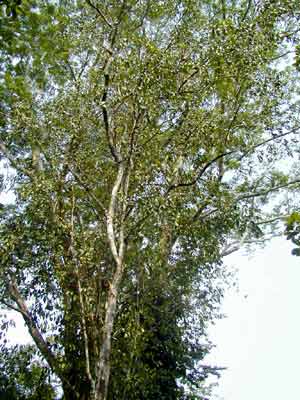|

|
|
Sandalwood |
Summer in South China is scorching hot. It is very hard for people to endure the heat. However, if one has an old-world fan made of sandalwood, he would enjoy the happiness of cool air blowing on his faces. Or after he takes a bath with sandalwood soap, he will feel fresh, and he will feel a faint fragrance stays in the air. The aroma of sandalwood is quite similar with the “strange sweetness” in
lady Daiyu’s sleeves in the famous Chinese novel “The Dream of the Red Mansion”.
Sandalwood is generally called the “king of all perfumes” and was cried up in all generations; besides, its price is fixed on the basis of Jin (half a kilogram). As a matter of fact, the thing is actually the marrow of the tree. Sandalwood is a sort of arbor and originates in South India and East Timor Isles of Indonesia. China has a history of more than 1000 years for the import of sandalwood. At that time, sandalwood was a precious perfume sacrificed to the Buddha. The wood came to China together with Buddhism; later on, it spread to the inland from Tibet, Yunnan and coastal areas; ardent believers, in order to express their strong belief in Buddhism, used to spend a lot of money to buy a small piece of sandalwood wood for the burning of incenses; later on, the wood was used in Chinese medicine, carving of craftworks and high-rank cosmetics. In Lama Temple of Beijing, there is a Buddha statute carved with sandalwood wood; the Buddha is 26 meters in height and with a diameter of 3 meters; it is a giant sandalwood tree bought by the 7th Generation Dalai Lama of Tibet from Nepal in order to express His thanks for Qing Dynasty for pressing down a rebellion in Tibet. The tree was shipped to Beijing in three years by more than 1000 of serfs. Many western countries have the custom to burn sandalwood wood in great occasions; when the former Premier of India, Madam Gandhi died, the government of India burned a ton of sandalwood wood.
Sandalwood wood has very strong anti-erosion capacities. In 1987, a Ming Dynasty tomb was unexcavated, because the husband used sandalwood wood for his coffin, his corpse was preserved very well; and the wife only used common wood for her coffin, so she only had a skeleton when unexcavated.
People could also extract essence oil from sandalwood wood through distillation, and the oil is widely used in medical treatment. It has the effects such as cooling and
tonifying cardiac, and could be used to treat gall illness, bladder illness and gonorrhea as well as stomachache, fever and vomiting etc. Sandalwood wood oil is also an important raw material for making perfume, soap, and cosmetics.
Though sandalwood wood has widespread use and very high economic values, if we investigate into their growing process, we will find that they are not so glorious at all. It won’t be so immoderate if we call it “a parasite”. Sandalwood is an evergreen parasitical arbor, and there are thousands of copulas in their roots; these copulas absorb nutrition from the plant they parasitize on, and it strives for nutrition, inorganic salt and other elements with them. Though sandalwood can have some nutrition from its own roots, it mainly lives on the nutrition of the plants they parasitized on. Sandalwood is quite fastidious about the plants they parasitize on, they mainly select leguminous plants such as
prettiest caesalpinia, jequirity etc. Besides, sandalwood is quite jealousy; if the trees they parasitizes on grow better than them or grow more exuberant than them, they would soon die away because of “angry”. Therefore, usually we can only see some sallow and emaciated plants under the exuberant sandalwood.
The transplantation of sandalwood is a hard work. In early times, some overseas Chinese brought back sandalwood seeds to plant in China. But, since its seeds have high oil contents, it is very easy for them to become decayed; they may lose the capacity to shoot up if they are kept for over half a year; therefore, numerous transplantation ended in failures. After many years of careful studies by the researchers, the transplantation of sandalwood in China achieved success in the 1960s. For the time being, we could see sandalwood are planted in Canton, Yunnan, Guangxi and Fujian etc. The researchers, based on the special features of sandalwood, would first plant some leguminous plants before they want to cultivate the sandalwood; when the sandalwood grow to a certain height, they would transplant it to the plants they parasitize
on. If the plant they parasitize on died away, the sandalwood would die too, except they are replaced by other plants in a timely manner.
If you come to Xishuangbanna for sightseeing, you can not only see exuberant
sandalwood trees, you could also buy some necklaces or bracelets made of sandalwood; their faint fragrance can not only keep you companion, but also bring you good lucks!


|